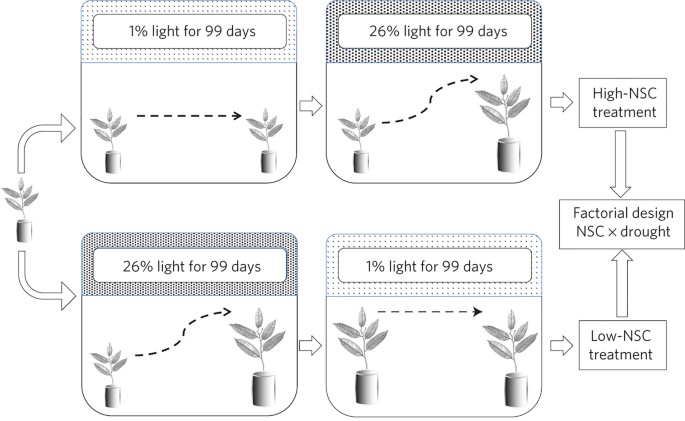Drought survival of tropical tree seedlings enhanced by non-structural carbohydrate levels
- Select a language for the TTS:
- UK English Female
- UK English Male
- US English Female
- US English Male
- Australian Female
- Australian Male
- Language selected: (auto detect) - EN

Play all audios:

Plants in most biomes are thought to be living at their hydraulic limits, and alterations to precipitation patterns consistent with climate change trends are causing die-back in forests
across the globe1,2,3,4. However, within- and among-species variation in plant traits that promote persistence and adaptation under these new rainfall regimes may reduce mortality in these
changing climates5,6. Storage of non-structural carbohydrates (NSCs) is posited as an important trait for resistance and resilience of forests to climate-change-induced drought, but the
underlying mechanisms remain unclear7,8,9,10. Here we demonstrate a positive relationship between NSCs and drought survival by manipulating NSC concentrations within seedlings of ten
tropical tree species. Seedlings experimentally enriched in NSCs showed higher stem water potentials and sustained NSCs during drought. NSC use for maintenance of osmoregulation and
hydraulic function therefore seems to underlie improved drought resistance. That drought mortality is delayed by higher NSC concentrations has implications for predicting the impacts of
climate change on forest die-back2,4 and may help focus restoration efforts on species that increase the resistance and resilience of forests to climate change.
This work was financially supported by the Swiss National Science Foundation (Grant 31003A_125461 to A.H.). We thank G. Reynolds for field support. Great appreciation goes to our
hard-working staff at the Sabah Biodiversity Experiment, especially P. Ulok, F. Osman and Achung. The Sabah Biodiversity Experiment is part of the Royal Society South East Asia Rainforest
Research Programme (Project No. RS243), and this research is manuscript number 10 of the SBE. This manuscript contributes to the UZH University Research Priority Program on Global Change and
Biodiversity.
Institute of Evolutionary Biology and Environmental Studies, University of Zurich, Winterthurerstrasse 190, CH-8057 Zurich, Switzerland
Institute for Applied Ecology New Zealand, School of Applied Sciences, Auckland University of Technology, Auckland 1142, New Zealand
Mountain Ecosystems WSL Institute for Snow and Avalanche Research, SLF, Flüelastrasse 11, CH-7260 Davos Dorf, Switzerland
School of International Tropical Forestry, University Malaysia Sabah, Jalan UMS, Kota Kinabalu, 88400 Sabah, Malaysia
Department of Plant Sciences, University of Oxford, OX1 3RB, UK
M.J.O’B. conceived, designed and carried out the experiment, extracted NSC, analysed the data and wrote the manuscript. S.L. contributed in designing the physiological method, analysis and
writing. C.D.P. contributed to the study design, analysis and writing. J.T. was the local collaborator helping with the logistics of research in Sabah. A.H. contributed to the study
conception, analysis and writing. Revisions were led by M.J.O’B. with input from all authors.
Anyone you share the following link with will be able to read this content: